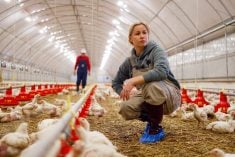CHICAGO, Dec 23 (Reuters) – Chicago Mercantile Exchange live cattle futures on Monday rose for a third straight session, buoyed by last Friday’s bullish U.S. Department of Agriculture’s monthly cattle-on-feed report, traders said.
Friday’s USDA data showed the number of cattle placed in U.S. feedlots dropped 3 percent from a year earlier as improved grazing land allowed ranchers to keep cattle out of feedyards longer.
Last week, cash cattle in Texas and Kansas moved at $130 per cwt, down $1 from the week before, feedlot sources said. They reported overall cash sales of $130 in Nebraska, which was roughly steady to $1 lower than the previous week.
Read Also

China lifts Brazilian poultry imports ban over bird flu
China lifted a ban linked to Brazil’s avian influenza outbreak, the country’s General Administration of Customs said in a notice released on Friday.
Monday morning’s wholesale choice beef price slipped 14 cents per cwt to $196.65, but select rose $1.18 to $189.61, based on USDA data.
“Packers will need cattle after the new year and grocers should start stocking up on beef for post-holiday consumer demand,” a trader said.
This week, however, beef processors may keep a lid on cash cattle given their poor margins and lukewarm beef demand, traders said. Also, packing plants will be closed at least one day each week during the winter holidays, limiting their packer need for cattle.
December live cattle finished 0.175 cent per lb higher at 132.700 cents, and February ended at 133.950 cents, up 0.050 cent.
Profit taking pressured January CME feeder cattle while the firm live cattle market lifted the March contract.
Feeder cattle for January closed at 166.675 cents, 0.300 cent lower, and March finished up 0.175 cent at 167.100 cents.
February and April CME hogs dipped on cash-price worries as packers curtail operations ahead of the Christmas and New Year’s holidays, traders and analysts said.
USDA’s morning direct hog prices were unavailable.
Hog brokers said cash hogs in the Midwest traded steady amid mixed demand from packers. Traders continue to eye wholesale pork demand amid ample near-term supplies of hogs at heavy weight.
The government’s morning wholesale pork price was down 18 cents per cwt to $85.21 as ham prices turned lower, USDA said.
Retail demand for ham is winding down for the holidays and the sufficient supply of heavy-weight hogs is making more pork available to end users, a trader said.
Investors lightly bought 2014 spring and summer hog futures in the belief that the spread of the Porcine Epidemic Diarrhea virus (PEDv), which is deadly to baby pigs, will dent hog production during that period.
February hogs closed down 0.050 cent per lb at 86.200 cents, and April ended at 90.950 cents, down 0.225 cent.














